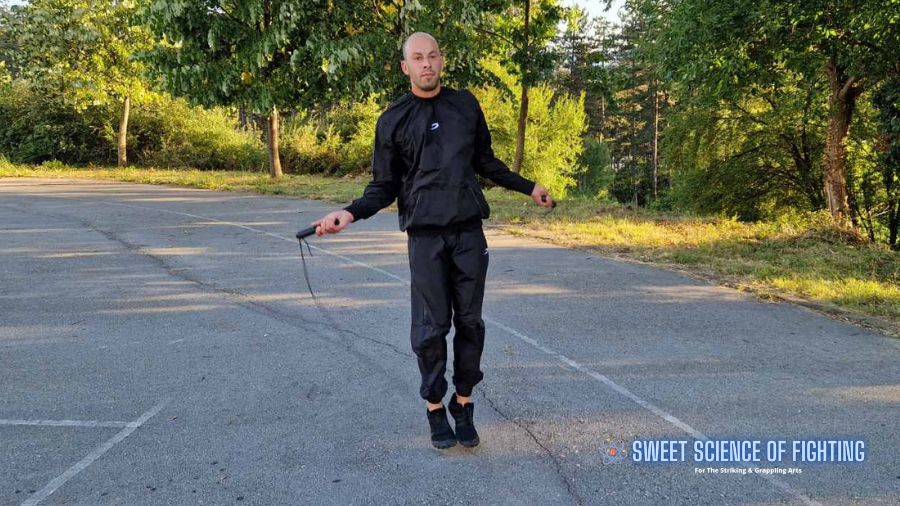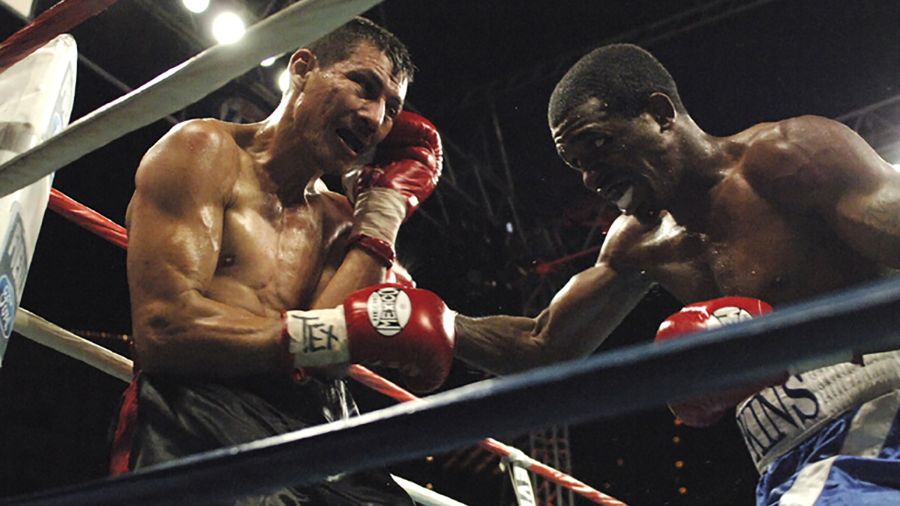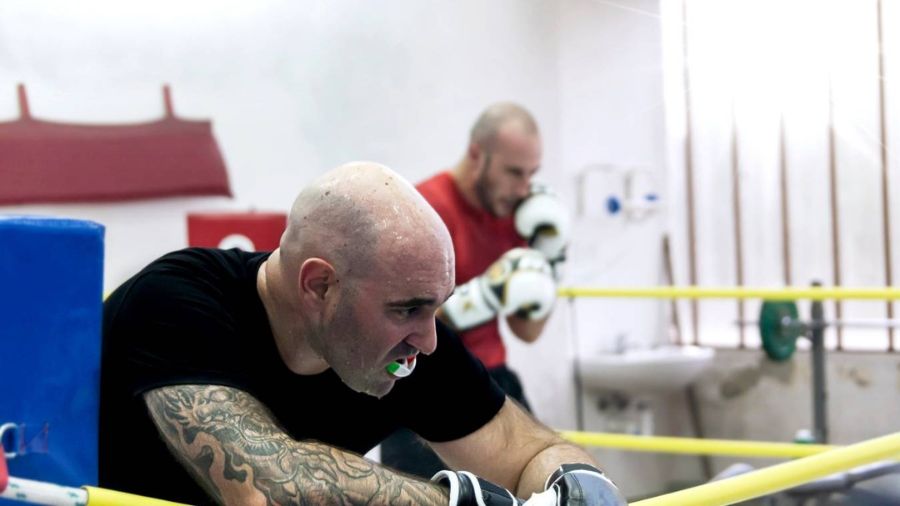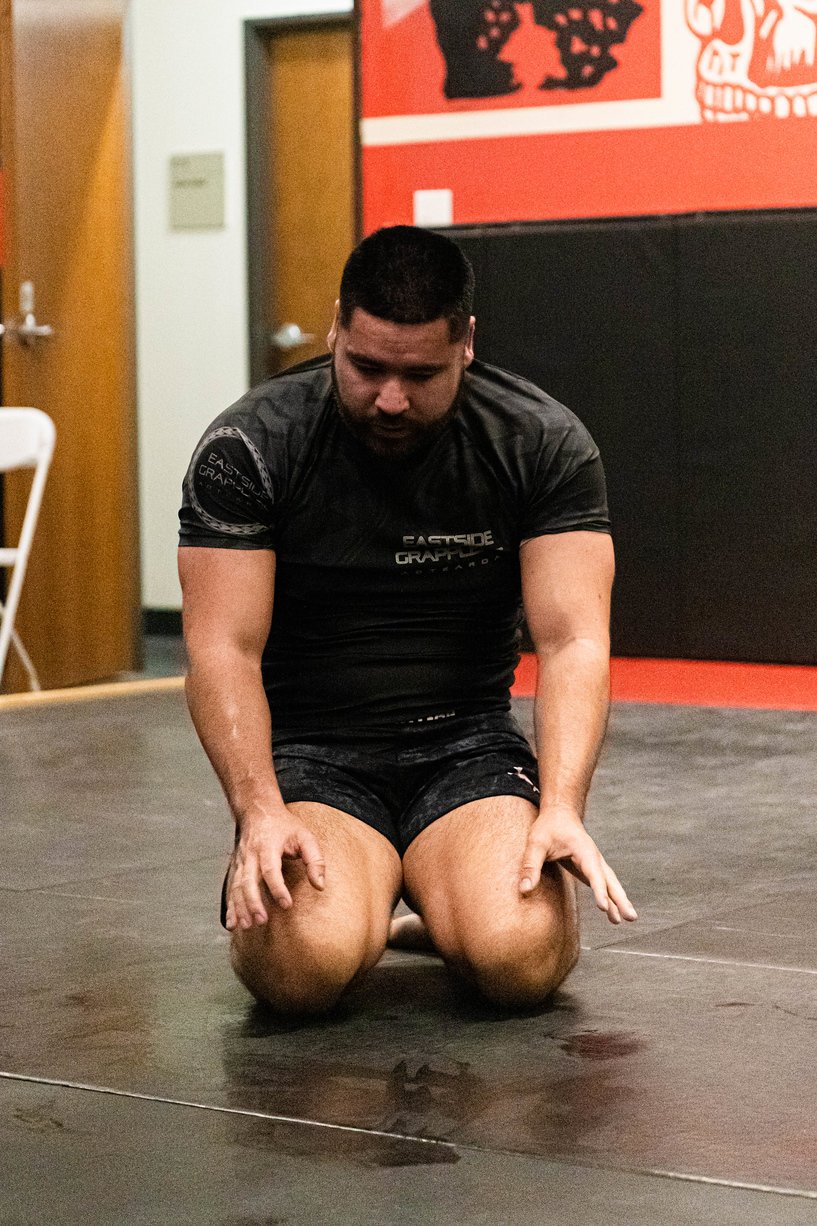So you’ve slogged your way through roadwork for months. Yet you still don’t feel “fit” when you fight and spar. You find yourself gassing out even with all the extra conditioning you do. So what does it actually take to become conditioned for boxing?
Successful boxers require aerobic capacity levels close to a triathlete as well as the ability to pump a lot of blood with each heartbeat. Conditioning for boxing should consist mainly of boxing performed in a way to stimulate specific aerobic adaptations to the heart and the muscle.
While the aerobic energy system plays an important role in boxing, so does the alactic energy system which is responsible for fuelling the quick bursts of punches and movements.
But what actually differentiates different levels of boxers? If we know this information, it can inform us about what the important qualities are to be a successful boxer.
For the purpose of this article, I’ve split the sections into amateur and professional boxing for obvious reasons. Mainly fight bout duration. However, there is NO research investigating professional boxing so I’ve had to make inferences from the amateur boxing research.

FREE Strength & Conditioning Program To Never Gas Out In The Ring
Physiological Demands of Non-Elite vs. Elite Amateur Boxing

When looking at the energy system contribution during an amateur boxing match, it becomes difficult to directly measure due to the striking nature of the sport.
Wearing gas masks during a fight is obviously not possible as taking punches to the equipment while it’s strapped to your face leads to broken equipment and extra facial damage.
So, much of the research has had to focus on match simulations or measuring blood lactate values between rounds. The current studies using match simulation have been researched well and we know that sparring and competitive fighting deliver similar physiological outcomes.
A 2014 study from the International Journal of Sports Physiology and Performance took 10 male novice boxers and put them through a semi-contact match simulation on the pads with typical attacking and defensive sequences [1]. 3 x 2-minute rounds were used with a 1-minute break between rounds.
They found there was an activity rate of 1.2 attacking and defensive maneuvers per second throughout the entire fight simulation.
While there was no clinching or referee stoppages, the activity rate was similar to a typical competitive bout.
Further, there was a reduction in the change in blood lactate values between rounds indicating that the ability to provide energy from the anaerobic lactic energy system diminishes as the fight progresses.
The authors concluded that amateur boxing when competing in a 3 x 2-minute format has energy system contributions of 77-85% aerobic, 19-9% anaerobic alactic, and 4-6% anaerobic lactic. This definitively flies in the face of traditional thought when it comes to boxing.
Not only does the aerobic energy system provide the majority of the energy during a round, but it is also essential to recovery between rounds through resynthesizing ATP for the alactic energy system.
However, the same authors later found when novice boxers compete, peak blood lactate was higher post-fight than during the simulation suggesting that anaerobic lactic contribution may be slightly higher during competitive fighting [2].
However, when compared to Commonwealth level boxers during a 4 x 2-minute match, the rate of lactate production far exceeds these elite boxers even when they threw 40% more punches than the novices in this study.
Thus, suggesting that the lower aerobic fitness level may be the reason why blood lactate was much higher compared to the Commonwealth boxers [3].
The elite Commonwealth level boxers in this study had very high aerobic capacity metrics with average VO2maxmeasures of 64 ml.kg-1.min-1. The researchers stress the importance of a well-developed aerobic energy system to not only improve recovery between rounds but to maintain performance over all 4 rounds.
In fact, a British Olympic medallist had a relative VO2max of 69 ml.kg-1.min-1 which is insane considering elite triathletes have values ranging from 70-80 ml.kg-1.min-1 [4]. Remember, VO2max is simply the maximum ability of the body to utilize oxygen which is vitally important for aerobic metabolism.
Further, the high post-fight blood lactate values show the important interplay between aerobic and anaerobic lactic energy systems [3].
Looking at more VO2max values of elite-level amateur boxers, Indian boxers were measured to have an average of 55-62 ml.kg-1.min-1 [5,6], Hungarian boxers an average VO2max value of 57 ml.kg-1.min-1 [7], and Lithuanian boxers an average value of 58 ml.kg-1.min-1 [10].
Further, a study looking at Olympic boxing athletes highlights the importance of a well develop aerobic energy system where oxygen update (aka VO2max) increased from 51 to 55 ml.kg-1.min-1 from round 1 to round 3 [8].
Therefore suggesting, that to maintain effort across all boxing rounds, energy must be provided mainly from the aerobic energy system especially as rounds progress as shown in novice boxers in the first studied review in this section [9].
Most interesting is the 2014 research by the Lithuanian National boxing team where they sought to find out if aerobic capacity differentiates boxing performance between elite boxers including 5 European Champions and 7 National Champions [10].
Each boxer was ranked based on their competitive performances in the previous year at major National and International competitions.
They found that the amount of blood that could be pumped in one heartbeat showed the strongest correlation with boxing sport mastery.
VO2max also showed a strong correlation with boxing mastery but not to the same extent as the ability to pump a lot of blood.
Piecing everything together, we can conclude that amateur boxing of 3 x 2, 3 x 3, and 4 x 2-minute rounds at either the novice or elite level requires predominantly aerobic energy system contribution. Further, even within elite level amateur boxers, aerobic capacity differentiates between those of higher skill level.
High levels of alactic contribution are needed for punching speed and force while the anaerobic lactic energy system plays a role in picking up any slack the aerobic energy system leaves behind regarding energy production.
Physiological Demands of Professional Boxing

Unfortunately, there is no scientific literature to date on the physiological demands of professional boxing. However, we can make inferences based on the data presented by amateur boxers.
Mainly, we can assume that professional boxing requires a high demand from the aerobic energy system. As discussed earlier, changes in blood lactate values between rounds decreases as the fight progresses.
Between the first and second round, blood lactate increased by 3 mmol/L while after the third round, the change in blood lactate only increased by 0.9 mmol/L [1].
We can assume that as a fight progresses, this increase in blood lactate is minimal and the aerobic processes dominate especially when fighting a 12 round professional fight.
We can also assume that large contributions come from the alactic energy system to supply the power for quick and hard punches.
Finally, the research in amateur boxing suggests the anaerobic lactic energy systems play a small role in overall energy contribution to boxing so training should have an aerobic-alactic focus.
Activity Profile of Non-Elite vs Elite Amateur Boxing
We know that amateur boxing is highly aerobic interspersed with high-intensity efforts. But what actions make up these rounds?
Activity to break ratio was found to be 9:1 in novice boxers when not including breaks between rounds where activity was counted as all attacking and defensive actions, and vertical hip movements [11]. The first round had the highest activity ratio of 16:1 in a 3 x 2-minute bout.
Regarding punching volume, these novice boxers averaged approximately 22 punches per minute. Over the whole fight, you are looking at 130 punches, 23 defensive movements, and 224 vertical hip movements.
Elite amateur boxers show a slightly different activity profile. This 2015 study analyzed 10 final and 19 semi-final bouts from all 10 weight categories at the London 2012 Olympics which were 3 x 3-minute fights [12].
While punches per minute were relatively similar to novice boxers at approximately 20 per minute, the activity to break ratio was double that of novice boxers at 18:1 highlighting the extreme conditioning elite amateur boxers possess.
Further, the activity rate per second increased over the 3 rounds from 1.2 to 1.4 actions per second with each minute consisting of approximately 20 punches, 2.5 defensive movements, and 47 vertical hip movements.
The activity to break ratio in the first round was 31:1 and in rare bouts, 85:1 activity to break ratio was present which is insane.
A separate study analyzing the 2012 London Olympics final bouts agrees with some of these findings where they found an increasing activity rate of punches per round [13]. Jabs made up two-thirds of these punches highlighting the need for a well-conditioned lead arm.
Finally, a 2020 study analyzed 8 elite male boxers from the 2012 London Olympics from the Round of 16 through to the final in the welterweight category [15]. These boxers threw an average of 82 punches per round which translates to roughly 27 punches per minute.
Punches thrown were even higher when it came to the gold medal winner who threw 105 punches per round translating roughly to 32 punches per minute.
Further, over half of the round time was spent moving around the ring highlighting the importance of lower body movement.
Activity Profile of Professional Boxing
Unfortunately, we don’t have any research to look at regarding activity in professional boxing. One can assume from the amateur boxing research that the activity rate is likely to increase as the rounds progress due to pacing and tactical strategies.
What Differentiates Winners And Losers in Amateur Boxing?

A 2013 study concluded that successful amateur novice boxers are able to maintain a high frequency of attacking movements, specifically the jab to the head together with punching combinations [11].
Winners were able to throw more punches and more successful punches throughout each round.
Further, they found there were no differences between winners and losers when it came to the number of defensive activities. Rather, winners were able to use their defensive actions to initiate a counterattack.
In English Regional and National level boxers, winning performance was characterized as having a larger number and success of attacking actions with fewer defenses [14].
Regional level bouts were found to have lower attacking and defensive activity compared with National level bouts likely due to the increased aerobic conditioning and skill level needed to compete over 3 x 3 minute vs 3 x 2-minute rounds.
As mentioned in the physiological demands section, even among elite amateur boxers, more successful boxers have greater aerobic capacity. Especially the ability to pump more blood per heartbeat [10].
Best Conditioning Exercises For Boxing
The best boxing conditioning exercises may not surprise you. But there are certain exercises that you may not have thought about. Further, certain exercises are better for some, depending on your boxing training schedule.
Shadowboxing
Conditioning is not solely about energy systems and “fitness.” It’s about being prepared for boxing. That means technical and tactical training is the most crucial aspect of your training. You can add more time performing technical training when you use boxing as a conditioning modality leveling up your skills and conditioning simultaneously.
This is most important if you only box a few times a week. If you have a professional boxing schedule, adding more boxing as conditioning may not be the best idea since you already box multiple times a day and week.
Use shadowboxing to target different adaptations. Long, low-intensity, continuous shadowboxing sessions for prioritizing aerobic adaptations and hard, high-intensity interval sessions to target anaerobic adaptations.
Jumping Rope
Jumping rope is a staple boxing conditioning exercise and should remain so. It develops ankle stiffness improving your reactive strength ability so you can be bouncy and explosive when moving around the ring.
You can jump rope as part of an aerobic capacity circuit presented later in this article or on its own as a cross-training exercise.
Heavy Bag Intervals
The heavy bag is often used in boxing class. However, use it as a tool for anaerobic conditioning and repeat power efforts. Hard efforts on the bag interspersed with rest intervals can be an effective way to do your boxing conditioning.
But don't be scared to flow with the heavy bag. You can use the bag for low-intensity aerobic work if you show some restraint.
Wrestling
“Wait… what? This isn't MMA." While boxing does have takedowns and submissions, it has a grappling and body manipulation component. The boxing clinch is a tactic often used in professional boxing to slow the fight's pace and even tire a larger opponent.
Want to know how to condition for this? Use wrestling principles during boxing clinch training as part of your conditioning. This works best when you have a training partner. Strength & conditioning coach Geoffrey Chui has a great video on this below:
Medicine Ball Circuits
Very rarely do I see medicine ball circuits used within boxing. They make the perfect conditioning modality to cross-train and spend time away from boxing while developing work capacity in movements similar to boxing.
For example, medicine ball rotational throws performed submaximally develop rotational capacity and rhythm. I like to pair medicine ball circuits with other conditioning exercises on this list, like shadowboxing and jumping rope.
Airdyne Bike
Traditional cardio equipment has its place. It's easier to control the intensity and set target paces. Further, it allows you to spend time off-feet to deload the body from the rigors of boxing. The Airdyne is your better off-feet cardio option because it’s full body.
Therefore, adaptations occur in the upper and lower body instead of one or the other. You can perform low-intensity air biking for prioritizing aerobic adaptations and harder intervals for prioritizing anaerobic adaptations.
Aerobic Capacity For Boxing
I’ve detailed the extreme importance of aerobic conditioning throughout this article. It would be too easy to tell you to just go run your roadwork and your aerobic conditioning will be taken care of.
However, we know that isn’t the sole answer to your boxing conditioning and it also doesn’t take care of the specific adaptations we are after.
Firstly, we need to address the ability to pump as much blood as possible per heartbeat. To do this, we need to perform aerobic exercise that will stimulate these adaptations to the heart.
For this, we need cardiac output (aka low-intensity, steady-state cardio) and cardiac power intervals.
Cardiac Output
This low-intensity conditioning is all about building volume through time. Heart rate should be kept between 130-150 BPM so you should ideally buy a heart rate monitor. They are much cheaper and easily accessible nowadays so it is worth getting one.
I use an older version of this Polar heart rate monitor (link to Amazon) which I would highly recommend. Don’t go with inaccurate wrist-worn fitness trackers.
By performing this type of work, we are increasing the size of the heart chamber where blood pools before being pumped around the body.
The larger the chamber, the more blood that can be collected, and therefore, more blood can potentially be pumped in each heartbeat.
Ideally, cardiac output is performed through boxing itself. Shadowboxing and bag work are perfect modalities to develop boxing specific conditioning. If you are boxing a lot and need to reduce your punching load, you can perform medicine ball circuits mixed with shadow boxing and skipping.
Here are some examples of how you can progress this.
Total Time | Modality | Time |
|---|---|---|
Week 1: 30 min | Shadowboxing | 15 min |
Cell | Bag work | 15 min |
Week 2: 40 min | Shadowboxing | 15 min |
Cell | Med ball throws | 10 min |
Cell | Bag work | 15 min |
Week 3: 50 min | Shadowboxing | 10 min |
Cell | Med ball throws | 10 min |
Cell | Skipping | 10 min |
Cell | Bag work | 10 min |
Cell | Shadowboxing | 10 min |
Week 4: 60 min | Shadowboxing | 12 min |
Cell | Med ball throws | 12 min |
Cell | Skipping | 12 min |
Cell | Bag work | 12 min |
Cell | Shadowboxing | 12 min |
This is just an example of how you could piece it together. You could do any combination of exercises or just one exercise for the allotted time.
Cardiac Power Intervals
Now we’ve addressed how we can increase the heart chamber size, we need to address the contractility of the heart. Essentially, the more forcefully the heart can contract, the more blood that can be pumped from the large heart chamber we are creating.
Performing this kind of aerobic conditioning also increases the endurance ability of the heart at high heart rates.
In order to do that, we need to up the intensity of exercise. You can perform these intervals with a variety of modalities. Again, if the boxing load is very high, you may benefit from performing these on off-feet cardio equipment.
However, heavy bag work is your best boxing specific option. It will allow you to throw your power combinations.
In order to perform cardiac power intervals correctly, you need to keep your heart rate as high as possible throughout the whole 1-2 minute working period. These are as brutal as they sound.
Because of the higher intensity nature of this modality, rest periods are generally long ranging between 2-5 minutes or when your heart rate is back down between 120-130 BPM [16].
In my experience, you will need close to all 5 minutes of recovery if you really put the maximum effort into these intervals. Here is how a 4 week progression could look on a heavy bag.
Week | Set/Rep | Load |
|---|---|---|
Week 1 | 4 x 60 sec | 2-5 min rest OR 120-130 BPM |
Week 2 | 6 x 60 sec | 2-5 min rest OR 120-130 BPM |
Week 3 | 8 x 60 sec | 2-5 min rest OR 120-130 BPM |
Week 4 | 10 x 60 sec | 2-5 min rest OR 120-130 BPM |
If you like, you could also increase time instead of sets.
Now that we’ve addressed central adaptations to the heart, we need to address the ability of the muscular to be able to utilize all of this extra oxygen. While hill sprints are a great way of doing this, we want a modality that is able to tax the upper body.
Aerobic Plyometrics
This is how you can improve the endurance capacity of our fast-twitch muscle fibers. This means you can maintain a higher power output for longer due to the improved ability to utilize oxygen for energy production.
Essentially, you want to perform an upper or lower body plyometric movement over a long period of time. Perform 8-10 plyometrics with 10-15 sec rest and repeat for 5-10 minutes over 1-3 sets [16].
Here is how you can implement this for lower and upper body work.
Week | Exercise | Set/Rep | Series |
|---|---|---|---|
Week 1 | Med Ball | 8 plyos/15 sec x 5 min | 2 sets |
Week 2 | OR Explosive Pushup | 8 plyos/15 sec x 7 min | 2 sets |
Week 3 | OR Squat Jump | 8 plyos/15 sec x 9 min | 2 sets |
Week 4 | Cell | 10 plyos/15sec x 5 min | 3 sets |
Alactic Power & Capacity
Like in my other conditioning articles, alactic power and capacity will be trained in a similar manner.
Alactic Power
5-6 reps or 7-10 seconds with 2-5 minutes rest. Fully recovery between efforts.
Alactic Capacity
10-12 x 10-15 seconds with 20-90 seconds rest. 8-10 minutes active recovery (shadow boxing) between sets.
These are best performed using boxing power combinations and when performing velocity/power work in the gym using various throws and jumps.
Anaerobic Lactic Capacity
Based on the research, there is little evidence to suggest needing to place an emphasis on developing this energy system. The final preparations for boxing will likely involve harder sparring which will take care of this for us.
Overall, if you develop very strong aerobic conditioning through emphasizing the heart adaptations listed above, you will be in good stead come fight day. Performing conditioning mainly through boxing itself will allow you to spend more time honing your skills while simultaneously getting the conditioning stimulus you need to be a successful boxer.
If you're after more boxing workouts, I highly recommend you check out my boxing workouts to make you a better boxer article.
Biggest, Baddest Gas Tank In Just 8 Weeks
The Dominate The Ring Conditioning System is specifically designed to develop elite level boxing cardio based on your easy to implement test results.


References
1. Davis, P., Leithäuser, R. M., & Beneke, R. (2014). The energetics of semicontact 3× 2-min amateur boxing. International journal of sports physiology and performance, 9(2), 233-239.
2. Davis, P., Wittekind, A., & Beneke, R. (2013). Amateur boxing: activity profile of winners and losers. International Journal of Sports Physiology and Performance, 8(1), 84-92.
3. Smith, M. S. (2006). Physiological profile of senior and junior England international amateur boxers. Journal of sports science & medicine, 5(CSSI), 74.
4. Hue, O., Gallais, D. L., Chollet, D., & Prefaut, C. (2000). Ventilatory threshold and maximal oxygen uptake in present triathletes. Canadian Journal of Applied Physiology, 25(2), 102-113.
5. Ghosh, A. K. (2010). Heart rate, oxygen consumption and blood lactate responses during specific training in amateur boxing. International Journal of Applied Sports Sciences, 22(1), 1-12.
6. Ghosh, A. K., Goswami, A., & Ahuja, A. (1995). Heart rate & blood lactate response in amateur competitive boxing. The Indian journal of medical research, 102, 179-183.
7. Joko, P. (1983). Physical and physiological characteristics of Hungarian boxers. Eur Box Mag, 8, 28-29.
8. de Lira, C. A. B., Peixinho-Pena, L. F., Vancini, R. L., Fachina, R. J. D. F. G., de Almeida, A. A., dos Santos Andrade, M., & da Silva, A. C. (2013). Heart rate response during a simulated Olympic boxing match is predominantly above ventilatory threshold 2: a cross sectional study. Open Access Journal of Sports Medicine, 4, 175.
9. Slimani, M., Chaabène, H., Davis, P., Franchini, E., Cheour, F., & Chamari, K. (2017). Performance aspects and physiological responses in male amateur boxing competitions: A brief review. Journal of Strength and Conditioning Research, 31(4), 1132-1141.
10. Bruzas, V., Stasiulis, A., Cepulenas, A., Mockus, P., Statkeviciene, B., & Subacius, V. (2014). Aerobic capacity is correlated with the ranking of boxers. Perceptual and motor skills, 119(1), 50-58.
11. Davis, P., Wittekind, A., & Beneke, R. (2013). Amateur boxing: activity profile of winners and losers. International Journal of Sports Physiology and Performance, 8(1), 84-92.
12. Davis, P., Benson, P. R., Pitty, J. D., Connorton, A. J., & Waldock, R. (2015). The activity profile of elite male amateur boxing. International journal of sports physiology and performance, 10(1), 53-57.
13. Kruszewski, M., Kruszewski, A., Kuźmicki, S., Sklepiński, Ł., Kępa, G., & Landowski, K. (2016). Boxing techniques based on the analysis of boxing tournament finals during Olympic Games in London in 2012. Journal of Combat Sports and Martial Arts, 7(1), 61-66.
14. Thomson, E., & Lamb, K. (2016). The technical demands of amateur boxing: Effect of contest outcome, weight and ability. International Journal of Performance Analysis in Sport, 16(1), 203-215.
15. Devesa, V. P., & Pons, T. C. (2020). Methodological analysis of boxing activity profile by category. Journal of Physical Education and Sport, 20, 2052-2060.
16. Joel Jamieson. Ultimate MMA Conditioning.


